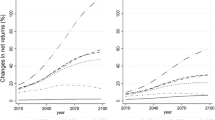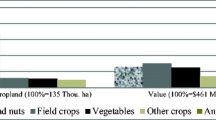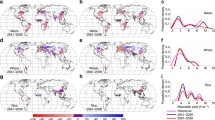Abstract
Many studies suggest that warming is harmful to American crop yields because of a temperature threshold near 30 °C whereupon yields abruptly fall. This study uses a flexible daily temperature bin specification in a Ricardian model to measure the response of farmland value to daily temperature. The analysis does not find evidence that high temperatures are particularly harmful to farmland or cropland value in the Eastern United States. Instead, temperature has a smooth hill-shaped effect on farmland value with a peak temperature of about 18 °C. Nonetheless, the Ricardian model predicts that cropland values would fall linearly by 15%/°C with uniform warming, while farmland values of mixed farms would fall far less.





Similar content being viewed by others
Notes
We do not use degree-days as in Schlenker et al. (2006) because a quadratic specification of degree-days between 8 and 32 °C is equivalent to a quadratic specification of the mean growing season temperature (Massetti et al. 2016). The correlation between the two temperature measurements is in excess of 0.99. The control of extreme temperature at 34ׄ °C is not robust and is set at an arbitrary value ibid.
We use the program developed by Solomon Hsiang: www.solomonhsiang.com/computing/stata-code.
Note that contrary to the crop yield literature, we use average daily temperatures, not hourly temperatures. An average daily temperature of 30 °C corresponds to a maximum daily temperature of about 36 °C. The next bin would collect extremely rare days with mean temperature greater or equal to 33 °C and a daily maximum of about 39 °C, the largest bin typically used by the crop studies. In the literature, hourly temperatures are often interpolated from daily minimum and maximum temperatures using the same formula for all days. This essentially means that hourly temperatures are rescaled daily temperatures.
In particular, the predicted value of land per hectare in each county is \( {\hat{y}}_{\mathrm{i}}=\mathit{\exp}\left({x}_{\mathrm{i}}^{\prime}\hat{\boldsymbol{\beta}}\right){N}^{-1}{\sum}_{\mathrm{i}=1}^N\mathit{\exp}\left({\hat{u}}_i\right) \).
Confidence intervals built using the percentile method are almost identical and are not reported.
We use c × m = 2,400. After adding all the observations over time for each county, we have a panel with 14,400 observations, which is very close to 14,460, the size of the full panel. The panel block bootstrap corresponds to the special case of m = 1.
References
Annan F, Schlenker W (2015) Federal Crop Insurance and the disincentive to adapt to extreme heat. Am Econ Rev 105:262–266
Blanc E, Schlenker W (2017) The use of panel models in assessments of climate impacts on agriculture. Rev Environ Econ Policy 11:258–279
Cameron AC, Trivedi PK (2005) Microeconometrics: methods and applications. Cambridge university press
Conley TG (1999) GMM estimation with cross sectional dependence. J Econ 92:1–45
Deschênes O, Greenstone M (2007) The economic impacts of climate change: evidence from agricultural output and random fluctuations in weather. Am Econ Rev 97:354–385
Duan N, Manning WG, Morris CN, Newhouse JP (1983) A comparison of alternative models for the demand for medical care. J Bus Econ Stat 1:115–126
Gammans M, Mérel P, Ortiz-Bobea A (2017) Negative impacts of climate change on cereal yields: statistical evidence from France. Environ Res Lett 12:054007
Hendricks NP (2018) Potential benefits from innovations to reduce heat and water stress in agriculture. J Assoc Environ Resour Econ 5:545–576
Massetti E, Mendelsohn R (2011a) Estimating Ricardian models with panel data. Clim Change Econ 2:301–319
Massetti E, Mendelsohn R (2011b) The impact of climate change on US agriculture: a repeated cross sectional Ricardian analysis. In: Mendelsohn R, Dinar A (eds) Handbook on climate change and agriculture. Edward Elgar
Massetti E, Mendelsohn R, Chonabayashi S (2016) How well do degree days over the growing season capture the effect of climate on farmland values? Energy Econ 60:144–150
Mendelsohn RO, Dinar A (2009) Climate change and agriculture: an economic analysis of global impacts, adaptation and distributional effects. Edward Elgar Publishing
Mendelsohn RO, Massetti E (2017) The use of cross-sectional analysis to measure climate impacts on agriculture: theory and evidence. Rev Environ Econ Policy 11:280–298
Mendelsohn R, Nordhaus WD, Shaw D (1994) The impact of global warming on agriculture: a Ricardian analysis. Am Econ Rev 84:753–771
Mesinger F, DiMego G, Kalnay E, Mitchell K, Shafran PC, Ebisuzaki W, Jovic D, Woollen J, Rogers E, Berbery EH (2006) North American regional reanalysis. Bull Am Meteorol Soc 87:343–360
National Agricultural Statistics Service (2010) Field crops: usual planting and harvesting dates. United States Department of Agriculture, Washington, D.C.
Ortiz-Bobea A (2013) Is weather really additive in agricultural production? Implications for climate change impacts. RFF Discussion Paper 13-41
Ortiz-Bobea A (2019) The role of nonfarm influences in Ricardian estimates of climate change impacts on US agriculture. Am J Agric Econ forthcoming
Ortiz-Bobea A, Knippenberg E, Chambers RG (2018) Growing climatic sensitivity of US agriculture linked to technological change and regional specialization. Sci Adv 4:eaat4343
Ritchie J, NeSmith D (1991) Temperature and crop development. Modeling plant and soil systems. Agron Monogr 31:5–29
Schlenker W, Lobell DB (2010) Robust negative impacts of climate change on African agriculture. Environ Res Lett 5:014010
Schlenker W, Roberts MJ (2009) Nonlinear temperature effects indicate severe damages to US crop yields under climate change. Proc Natl Acad Sci 106:15594–15598
Schlenker W, Hanemann WM, Fisher AC (2005) Will US agriculture really benefit from global warming? Accounting for irrigation in the hedonic approach. Am Econ Rev 95:395–406
Schlenker W, Hanemann WM, Fisher AC (2006) The impact of global warming on US agriculture: an econometric analysis of optimal growing conditions. Rev Econ Stat 88:113–125
Acknowledgments
We would like to thank seminar participants at the Ifo Seminar Series and at the ASSA 2014 Conference in Philadelphia for useful comments. We are also grateful to Wolfram Schlenker and Michael Roberts for sharing their weather data with us. NCEP Reanalysis data provided by the NOAA/OAR/ESRL PSD, Boulder, Colorado, USA, from their website at http://www.esrl.noaa.gov/psd/. Yeon Hak Kim and Evan Mistur provided excellent research support.
Funding
The research leading to these results has received funding from the European Union Seventh Framework Programme (FP7-2007-2013) under grant agreement no. 272608 (project CLI-EMA).
Author information
Authors and Affiliations
Corresponding author
Additional information
Publisher’s note
Springer Nature remains neutral with regard to jurisdictional claims in published maps and institutional affiliations.
Electronic supplementary material
ESM 1
(DOCX 522 kb)
Rights and permissions
About this article
Cite this article
Massetti, E., Mendelsohn, R. Temperature thresholds and the effect of warming on American farmland value. Climatic Change 161, 601–615 (2020). https://doi.org/10.1007/s10584-020-02694-6
Received:
Accepted:
Published:
Issue Date:
DOI: https://doi.org/10.1007/s10584-020-02694-6




